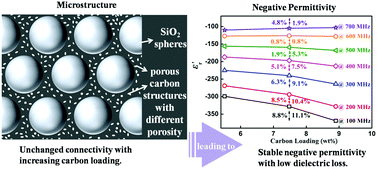Silica microsphere templated self-assembly of a three-dimensional carbon network with stable radio-frequency negative permittivity and low dielectric loss†
Abstract
Percolative composites always suffer from their unstable and filler-loading dependent microstructures and negative electromagnetic parameters. Here, stable negative permittivity is achieved by in situ constructing a three-dimensional carbon network in the silica spherical matrix after a self-assembly and pyrolysis process. An electrical percolation phenomenon appears with the formation of a carbon network. Once the carbon network is formed, further increasing carbon loadings will only influence the porosity rather than the connectivity due to the nature of the porous carbon itself. Hence, the microstructure and plasma-like negative permittivity are not sensitive to carbon loading, leading to a negligible carbon loading dependent permittivity behavior. Moreover, negative permittivity with small values (−100 < ε′ < 0), beneficial for matching with permeability, was effectively adjusted by changing the carbonization temperature. The carbon composites with negative permittivity showed an extremely low dielectric loss (tan δ = 1–7) compared with metal composites (usually tan δ = 10–100). This work provides a convenient means to obtain stable negative permittivity properties. The carbon composites can be regarded as a promising candidate for metamaterials and will facilitate the applications of materials with negative electromagnetic parameters.



 Please wait while we load your content...
Please wait while we load your content...